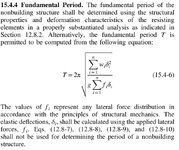This is a follow up question to the thread from 6/4 about ASCE 7-16 15.4-6
The commentary about the equation says to use lateral forces to determine deflection.
However, wouldn't you need to consider dead load in that load combo as well when deflection is calculated?
Asking because I've ran it with just lateral forces and lateral forces+dead and you get different deflections.
You can't act like dead isn't there and calc deflections based on lateral only, can you? It just doesn't sound right. Comparing this method with RISA's Eigensolution, it sounds like in RISA's general reference that mass is included.
In the example below I'm not quite sure if the seismic weight was considered in the same load combo when deflection are calculated.
https://res.cloudinary.com/engineering-com/image/upload/v1639177951/tips/Rayleigh_Method_m3ghfj.pdf
Appreciate it!
The commentary about the equation says to use lateral forces to determine deflection.
However, wouldn't you need to consider dead load in that load combo as well when deflection is calculated?
Asking because I've ran it with just lateral forces and lateral forces+dead and you get different deflections.
You can't act like dead isn't there and calc deflections based on lateral only, can you? It just doesn't sound right. Comparing this method with RISA's Eigensolution, it sounds like in RISA's general reference that mass is included.
In the example below I'm not quite sure if the seismic weight was considered in the same load combo when deflection are calculated.
https://res.cloudinary.com/engineering-com/image/upload/v1639177951/tips/Rayleigh_Method_m3ghfj.pdf
Appreciate it!

